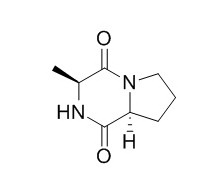Cyclo(L-Ala-L-Pro)
Cyclo(L-Ala-L-Pro) and cyclo(L-Val-L-Pro) inhibit aflatoxin production of Aspergillus parasiticus and Aspergillus flavus in liquid medium at concentrations of several hundred uM without affecting fungal growth.
Inquire / Order:
manager@chemfaces.com
Technical Inquiries:
service@chemfaces.com
Tel:
+86-27-84237783
Fax:
+86-27-84254680
Address:
1 Building, No. 83, CheCheng Rd., Wuhan Economic and Technological Development Zone, Wuhan, Hubei 430056, PRC
Providing storage is as stated on the product vial and the vial is kept tightly sealed, the product can be stored for up to
24 months(2-8C).
Wherever possible, you should prepare and use solutions on the same day. However, if you need to make up stock solutions in advance, we recommend that you store the solution as aliquots in tightly sealed vials at -20C. Generally, these will be useable for up to two weeks. Before use, and prior to opening the vial we recommend that you allow your product to equilibrate to room temperature for at least 1 hour.
Need more advice on solubility, usage and handling? Please email to: service@chemfaces.com
The packaging of the product may have turned upside down during transportation, resulting in the natural compounds adhering to the neck or cap of the vial. take the vial out of its packaging and gently shake to let the compounds fall to the bottom of the vial. for liquid products, centrifuge at 200-500 RPM to gather the liquid at the bottom of the vial. try to avoid loss or contamination during handling.
Proc. Sci. Math.2024, V25:108-123
Planta Med.2023, a-2192-2281.
Food Chem X.2024, 21:101208.
Reprod Sci.2022,10.1007/s43032-022-01117-4.
BMB Rep.2020, 53(4):218-222.
Environ Toxicol.2023, 38(7):1641-1650.
Histol Histopathol.2022, 18518.
Sci Rep. 2024, 14(1):70.
RSC Adv.2023, 13(9):6317-6326.
J Ethnopharmacol.2019, 236:31-41
Related and Featured Products
Microbiology. 2013 May;159(Pt 5):902-12.
Prevention of aflatoxin contamination by a soil bacterium of Stenotrophomonas sp. that produces aflatoxin production inhibitors.[Pubmed:
23449921]
A soil bacterium, designated strain no. 27, was found to produce aflatoxin-production inhibitors. The strain was identified as a species of the genus Stenotrophomonas, and was found to be closely related to Stenotrophomonas rhizophila.
METHODS AND RESULTS:
Two diketopiperazines, Cyclo(L-Ala-L-Pro) and cyclo(L-Val-L-Pro), were isolated from the bacterial culture filtrate as main active components. These compounds inhibited aflatoxin production of Aspergillus parasiticus and Aspergillus flavus in liquid medium at concentrations of several hundred μM without affecting fungal growth. Both inhibitors inhibited production of norsorolinic acid, a biosynthetic intermediate involved in an early step of the aflatoxin biosynthetic pathway, and reduced the mRNA level of aflR, which is a gene encoding a key regulatory protein necessary for the expression of aflatoxin-biosynthetic enzymes. These results indicated that the inhibitors targets are present in early regulatory steps leading to AflR expression. Co-culture of strain no. 27 with aflatoxigenic fungi in liquid medium effectively suppressed aflatoxin production of the fungus without affecting fungal growth. Furthermore, application of the bacterial cells to peanuts in laboratory experiments and at a farmer's warehouse in Thailand by dipping peanuts in the bacterial cell suspension strongly inhibited aflatoxin accumulation. The inhibitory effect was dependent on bacterial cell numbers.
CONCLUSIONS:
These results indicated that strain no. 27 may be a practically effective biocontrol agent for aflatoxin control.
Toxins (Basel). 2017 Jul 12;9(7).
The Mode of Action of Cyclo(l-Ala-l-Pro) in Inhibiting Aflatoxin Production of Aspergillus flavus.[Pubmed:
28704973 ]
Cyclo(L-Ala-L-Pro) inhibits aflatoxin production in aflatoxigenic fungi without affecting fungal growth. The mode of action of Cyclo(L-Ala-L-Pro) in inhibiting aflatoxin production of Aspergillus flavus was investigated.
METHODS AND RESULTS:
A glutathione S-transferase (GST) of the fungus, designated AfGST, was identified as a binding protein of Cyclo(L-Ala-L-Pro) in an experiment performed using Cyclo(L-Ala-L-Pro)-immobilized Sepharose beads. Cyclo(L-Ala-L-Pro) specifically bound to recombinant AfGST and inhibited its GST activity. Ethacrynic acid, a known GST inhibitor, inhibited the GST activity of recombinant AfGST and aflatoxin production of the fungus. Ethacrynic acid reduced the expression level of AflR, a key regulatory protein for aflatoxin production, similar to Cyclo(L-Ala-L-Pro).
CONCLUSIONS:
These results suggest that Cyclo(L-Ala-L-Pro) inhibits aflatoxin production by affecting GST function in A. flavus, and that AfGST inhibitors are possible candidates as selective aflatoxin production inhibitors.



